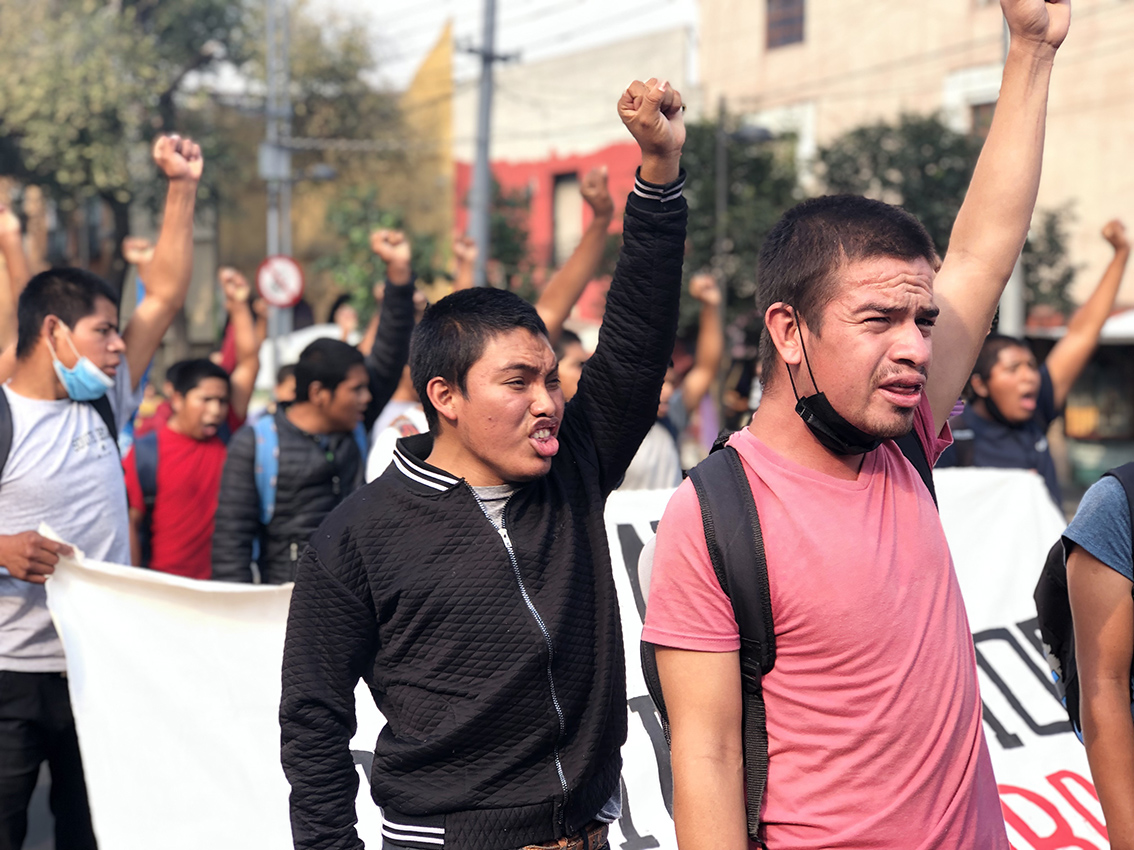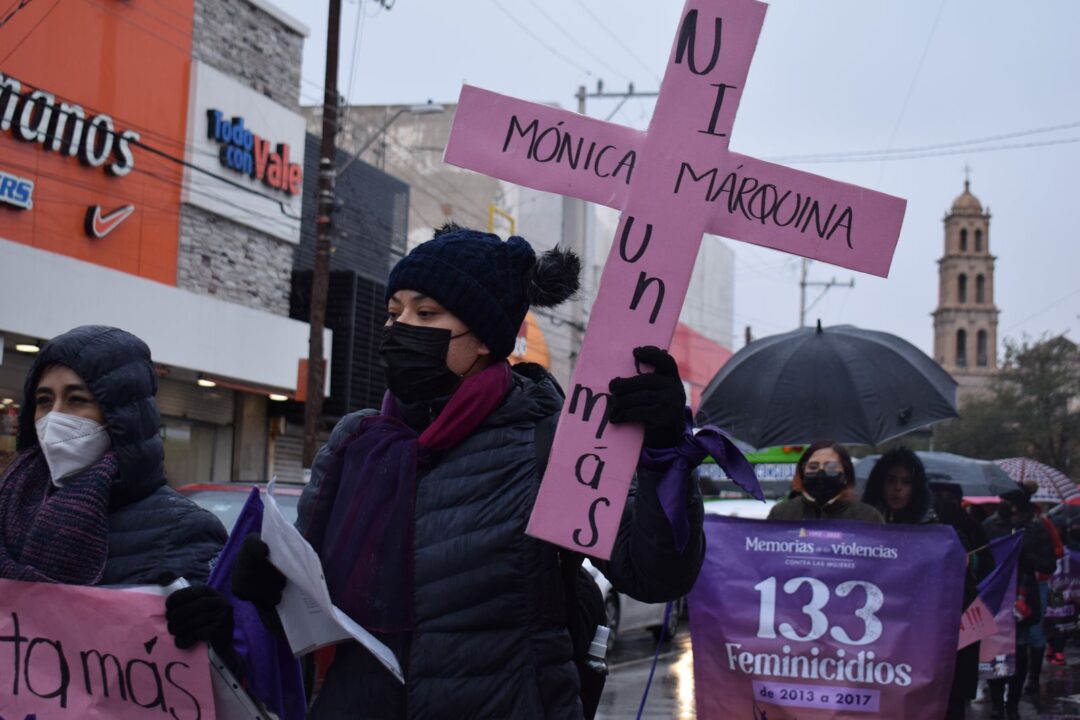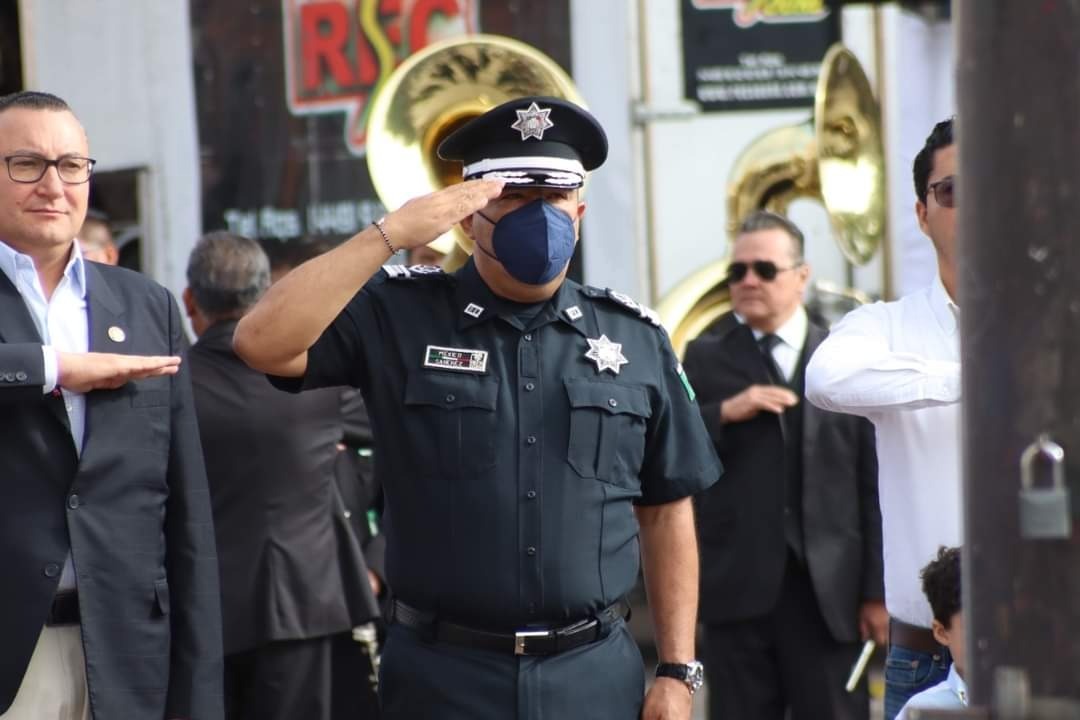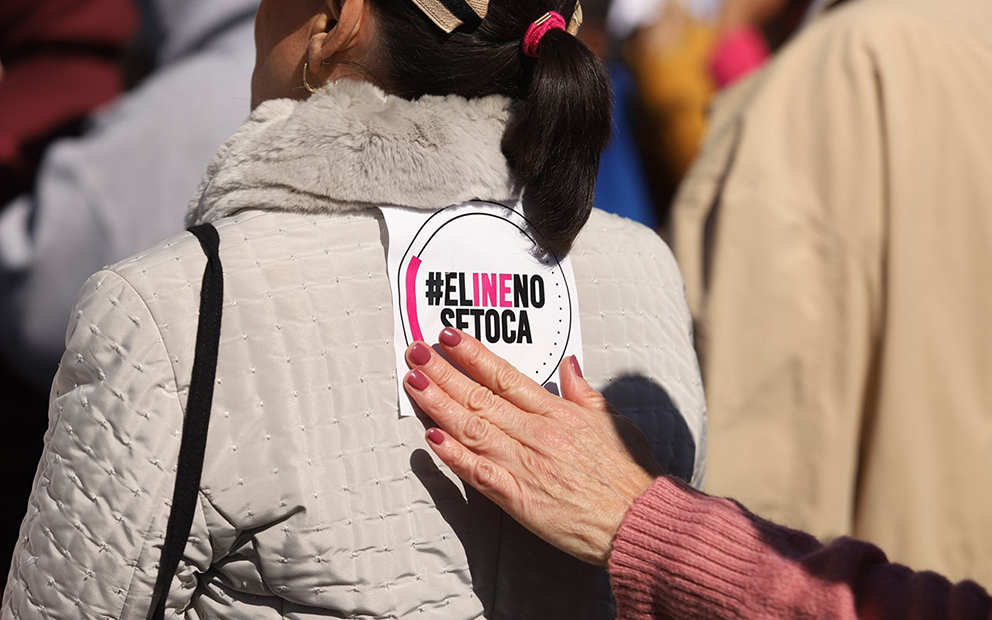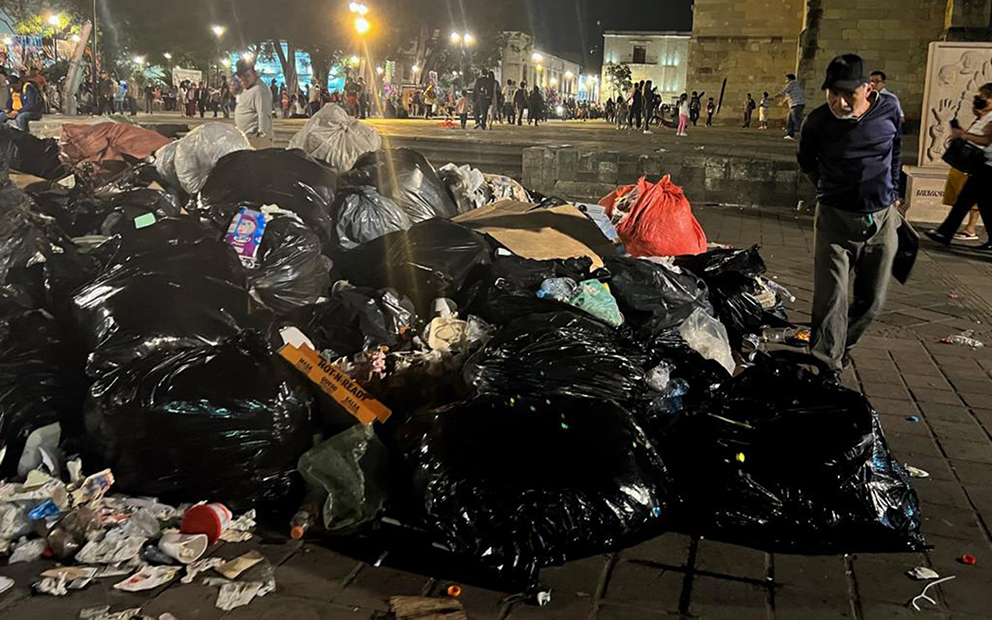On October 2nd, the 53rd annual commemorative march for the anniversary of the Tlatelolco massacre took place in Mexico City. Participants demanded justice and truth following serious rights violations in Mexico more than 50 years ago, and seven years ago in the case of Iguala.
Text by Kau Sirenio, originally published October 2nd, 2021.
Photos by Alexis Rojas.
Translated by Elysse DaVega.
MEXICO CITY–Before the stone thrown by a young man at a wall of police officers hits the ground, there’s a loud explosion on the police’s side that paints the sky red and grey.
In the middle of the chaos, as young people run desperately, a woman shouts angrily: “Police, repression is a crime.” No one pays her any mind as they search for hiding spots, but the street leaves them exposed.
While this takes place between Violeta and Pensador Mexicano streets off of Eje Central, the march advances to the flat expanse of the Zócalo, the plaza surrounded by governmental buildings. The 68 Committee is at the forefront. They are followed by the parents of the 43 missing students of the Ayotzinapa rural teachers’ college as well as current students from the school, who are accompanied by the Federation of Socialist Rural Students of Mexico (FECSM).
University students and rural education students participated in a commemorative march for the 53rd anniversary of the Tlatelolco student massacre. They demand justice and truth following serious rights violations in Mexico more than 50 years ago, and seven years ago in the case of Iguala.
The day of justice and truth started at noon in the Plaza of the Three Cultures in the Tlatelolco area. It began with prehispanic dances in front of the monument to the fallen. Two hours later, collectives, social organizations, university students and rural education students held a meeting to reorganize after inactivity caused by the pandemic.
The September 9th Collective of the National Polytechnic Institute (IPN) called the next meeting for October 23, with no set time:
Comrades, we’re going to organize from communities and neighborhoods to fight for the right to education and food, and combat the policies that damage our country. We need to meet on October 23 to build an independent organization free of [political] parties. We’ll set the time at a later date.
After the meeting, the group banded together and descended the steps in front of the Chihuahua building, where snipers had shot from 53 years before. They then moved through the parking lot and took Ricardo Flores Magón Street.
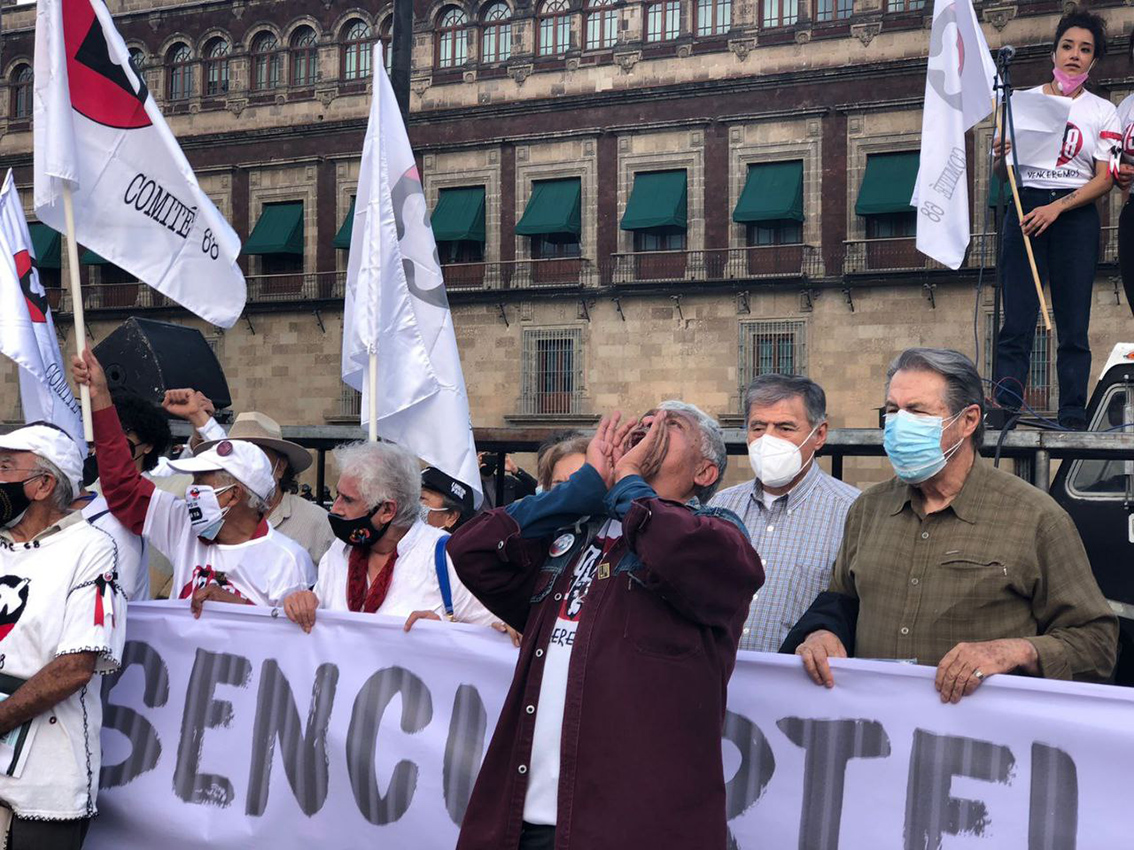
Open the barracks
The 68 Committee carries a giant banner suspended on a pole reading «Let’s find the truth,» the parents of the 43 of Ayotzinapa follow behind them. Meanwhile, the school’s recently-admitted students shout the same demand from seven years ago: «Because they took them alive, we want them back alive.» Behind them, the FECSM responded, chanting «No forgiving, no forgetting, punishment for the guilty.»
At the intersection of Eje Central and Flores Magón, university students, trade unionists and social and grassroots organizations wait their turn to join the human river painted red with union flags. Students from UNAM, UAM and the IPN walk together, just as they did more than half a century ago when the first shots from the Mexican Army and the Olimpia Battalion fell upon them.
As IPN students watch the parents of the 43 disappeared students of Ayotzinapa pass, they begin to count to 43. Then they shout their demand for justice: «Safe return, and punishment for the guilty.»
This is how they continued, chanting and vandalizing walls they encountered on the way. A few meters away, two young people with their faces covered paint a building’s curtains with the signature of October 2nd march: «IT WAS THE STATE.»
From Violeta Street and Eje Central onwards, riot police observe the march while rural normal students from the FECSM shout chants: «These are the ones screwing up the country!» A group of normalist students from Michoacán join in: «Idiot cops, the government exploits you too.»
When the 68 Committee turned onto May 5th Street, around the Pensador Mexicano neighborhood of the city, a quarrel broke out between students from UNAM, UAM, and the IPN. With explosions from police and stones thrown by students, the back end of the protest turned to chaos.
Conflict, as always, at the rear
The Banking and Industrial Police Force (PBI) closed off the back end of the march, the majority of whom were students from UNAM, UAM, and the IPN. After a helicopter flew over the area, the police fell back. Protesters pushed forward from Hidalgo avenue, and a group of reporters ended up detained with around 20 IPN students that escaped the first detention.
To bring attention to their ongoing detention, the university students burn cardboard signs and chant: «Let us go, let us go.» The rest of the students respond: «Freedom, freedom, freedom, to students who fight.»
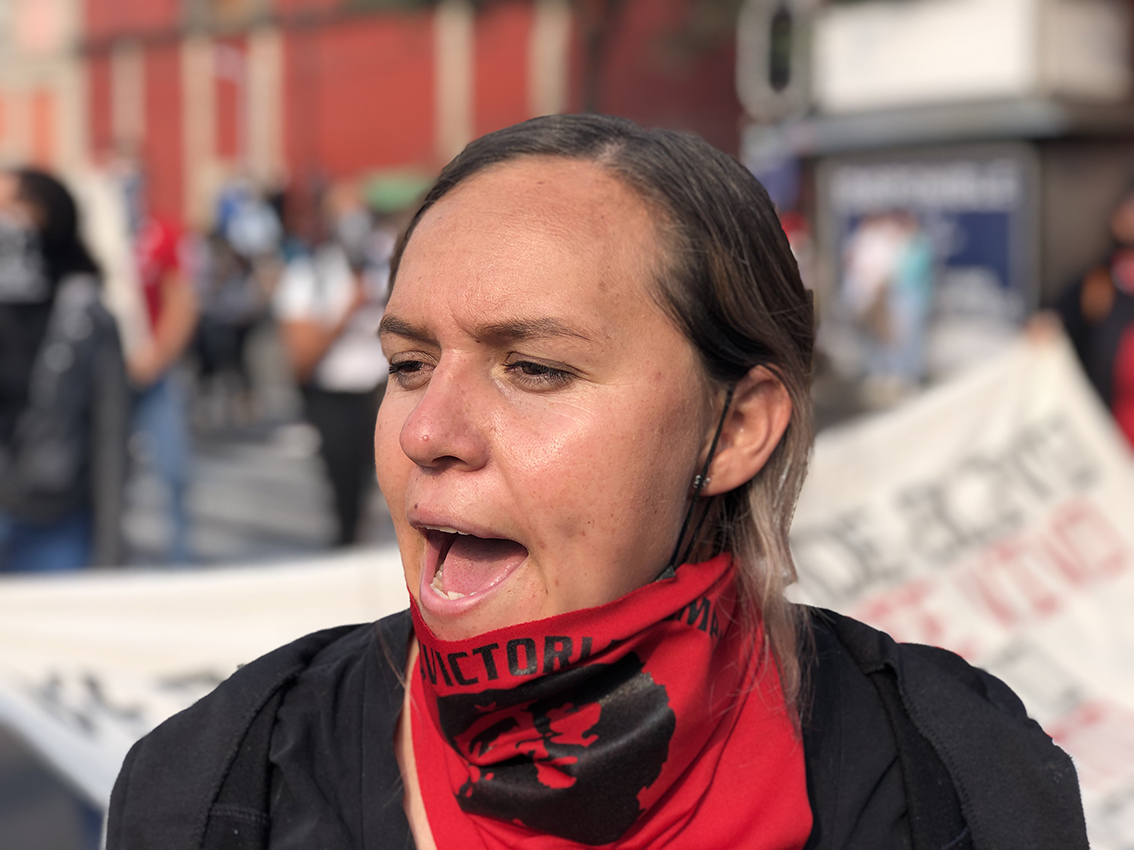
The first attempt to break through the wall of police was at 6:53 in the evening. A group of around 20 students linked arms to rush the police barrier, without success. Minutes later, they were told that they could proceed and join their detained classmates. They were applauded as they arrived, celebrating the triumph after breaking the police wall.
Meanwhile, in the Zócalo, Félix Hernández mentioned a series of aggressions against students in Mexico:
1968 and 1971; also against Zapatismo in Acteal the Mexican state attacked; attacks in Ayotzinapa that had an anniversary just a few weeks ago; against rural education students in Chiapas, adding itself to ongoing demand. There must be justice.
The gathering ended, and the back end of the human chain, the one that took the streets to demand justice and truth for events that occurred 53 years ago, was escorted by thousands of Mexico City police officers toward the Lagunilla market.
Kau Sirenio is a Ñuu Savi journalist originally from the Costa Chica region of Guerrero. He was a reporter with the newspaper El Sur de Acapulco and La Jornada Guerrero, host of the bilingual program Tatyi Savi (voice of the rain) on Guerrero Radio and TV and the Autonomous University of Guerrero Radio XEUAG in the Tu’un Savi language. He is currently a reporter with the weekly Trinchera.
Click here to sign up for Pie de Página’s bi-weekly English newsletter.
Ayúdanos a sostener un periodismo ético y responsable, que sirva para construir mejores sociedades. Patrocina una historia y forma parte de nuestra comunidad.
Dona

